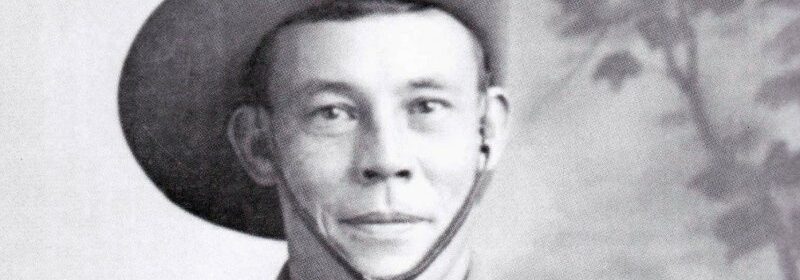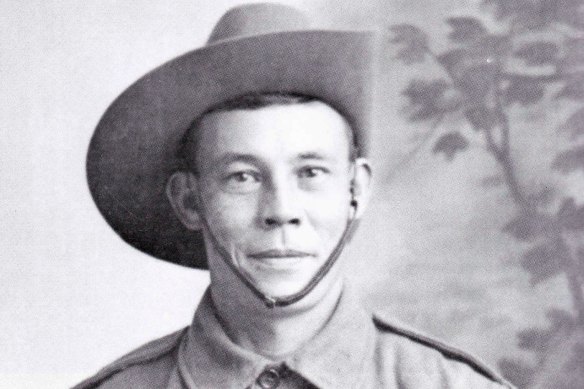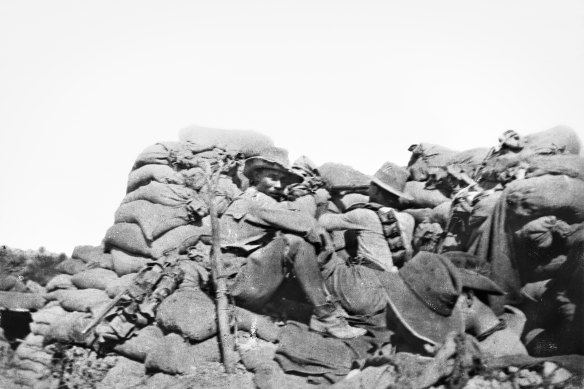The Anzac legend belongs to all of us, not just white Australia

Save articles for later
Add articles to your saved list and come back to them any time.
Australia’s cherished Anzac tradition has often been told as a white Australian story. The true picture, however, is more nuanced and colourful than we’ve long been led to believe.
Although the Commonwealth Defence Act in 1909 provided that “only British subjects substantially of European origin should be recruited”, among the 420,000 Australians who enlisted in the Australian Imperial Forces were Indigenous Australians as well as Aussies with Asian and South American heritage.
Chinese-Australian Billy Sing fought at Gallipoli.
The Australian War Memorial website documents the 104th person to enlist. Edward Harvey Statham was a Brazilian-British-Australian man born in Rio de Janeiro. Statham’s battalion landed at Gallipoli on April 25, 1915 after which he was listed as missing in action and, like so many others, presumed killed. Then there are the Finnish-Russian Australians who served in the Imperial Camel Corps fighting in the Middle East.
A recent book by Australian war historian Will Davies tells the stories of 241 Chinese-Australian diggers who fought in the Great War. Nineteen would be recognised for bravery and more than one in five never came home.
They were men like Billy Sing, the five-foot-five sniper with up to 300 kills to his name who grew up in the Australian bush driving horses and was awarded a Distinguished Conduct Medal. Or Victor Lepp, one of three brothers from Ballarat who went to Gallipoli and fought on the Western Front but was killed at Pozieres in 1916. And Nelson Sing, an 18-year-old boat builder who fought at Gallipoli, Pozieres and Passchendaele and who was killed in the French village of Montbrehain on 6 October 1918, just weeks before the end of the war.
These Chinese-Australian Anzacs were mostly descendants of Chinese gold rush settlers, who lived as outcasts due to the racism of the day. We do not know how many Aussie diggers were of other cultural backgrounds but who had Anglicised their names in an effort to better fit in.
Most Australians would never have heard of these men, their achievements or their sacrifices. Until recently, they were never afforded the respect of being written into the nation-defining Anzac mythology of Australia.
Indigenous Anzacs suffered even graver injustices. Alexander McKinnon was an Aboriginal digger who died in action, but whose war gratuity was awarded to the Protector of Aborigines in South Australia because that state’s laws prevented a serviceman’s next-of-kin from inheriting their gratuity and medals.
In truth, the Anzac legend belongs to people of many backgrounds. Some had to fight for the opportunity to do their duty for their country. Chinese digger Sidney Wah Shang struggled to be accepted into the army due to his race and stature. According to his great-granddaughter, his attitude would have been: “I have the same right to fight for king and country as anyone else”.
In this defiant sentiment lies an uncelebrated element of the Anzac spirit: that beyond courage, larrikinism and mateship, there is also the notion that being Australian has nothing to do with the colour of your skin, and everything to do with your contribution to the nation.
The Chinese Anzacs show how absurd it is that Chinese-Australians should be targeted for supposedly being in cahoots with a foreign power.
This untold story of the Chinese Anzacs also provides some poignant context to the current debate about Australia’s strained relationship with China, the increasing security dimensions of that tension, and its impact on Australians of Chinese heritage.
The Anzac legend was forged during the Great War, between 1914-1918, some three decades before Chairman Mao proclaimed the formation of the People’s Republic of China (PRC) in 1949. Indeed, the first recorded Chinese settler, Mak Sai Ying, landed in Sydney aboard the convict ship the Laurel in 1818, some 100 years earlier. He was a skilled carpenter employed by pioneer John Blaxland at Sydney’s Newington Estate and, coincidentally, an early ancestor of my brother-in-law.
The gold rushes in NSW and Victoria in the 1850s would bring thousands more Chinese to Australia. In other words, Chinese people had already lived in Australia for a century before World War I.
Yet, a 2022 report by the Lowy Institute found that one in three Chinese-Australians suffer discrimination due to their Chinese background. One in four have been called offensive names and, disturbingly, almost one in five have been physically threatened or attacked over the past year because of their heritage. No doubt, the spike in racism towards Chinese-Australians is caused at least in part by rising geopolitical tensions.
The story of the forgotten Chinese Anzacs shows how absurd and wrong it is that Chinese-Australians as a blanket group should be targeted and distrusted for supposedly being in cahoots with a foreign power.
Billy Sing and comrades in Gallipoli.Credit: Australian War Memorial
We must defend our Australian values and sovereignty. Yet in doing so it is critical that we do not undermine those very values by distrusting our own citizens because of their cultural background. Being Australian means that we all, apart from our First Nations people, have come from somewhere else.
The strength of our democracy lies in the confidence with which Australians of diverse cultural backgrounds can celebrate their heritage whilst being proudly Australian. Chinese-Australians can celebrate Chinese New Year just as Australians of Irish heritage celebrate St Patrick’s Day, Indian-Australians celebrate Diwali, Muslim Australians celebrate Eid al-Fitr and the Americans among us celebrate Thanksgiving.
It is the difference we all share that unites us as Australians. As the Anzac story evolves and becomes more diverse and colourful, it is becoming a spirit that can be celebrated and embraced by all Australians regardless of their background. Our sacred Anzac legend remains relevant and revered because it has recognised our diverse community is a seminal part of the story. This movement to reveal more layers to the Anzac story is important for our evolving identity and celebrates the fact that proud Australians come from everywhere.
The Opinion newsletter is a weekly wrap of views that will challenge, champion and inform your own. Sign up here.
Most Viewed in National
From our partners
Source: Read Full Article

